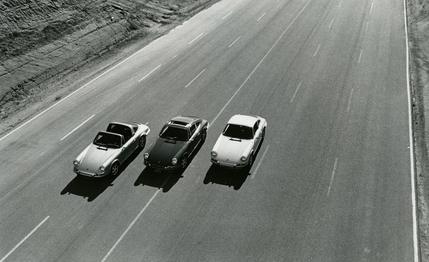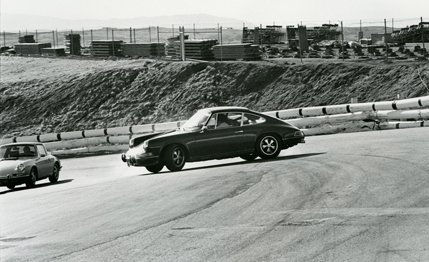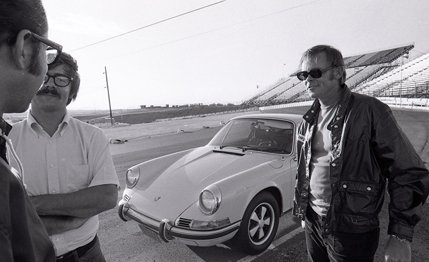
 Archived Comparison
Archived Comparison
Turn six at Riverside is an irregular U-bend at the top of a hill, lined on the outside by a solid white fence to keep errant racers out of the grandstands. The 911T was into six first, hard on the brakes, with the S Coupe and the E Targa tight on its tail.
Being in the rear car is like being in the caboose of a very short train and there is a kind of poetry to the motion of the cars ahead that a trackside spectator never sees. Everything happens in sequence: brake lights glow red, noses dive, car bodies gradually lean away from the turn, puffs of smoke balloon out of the exhausts as drivers downshift . . . it all seems so fluid, so continuous, almost artistic.
Suddenly it is chaos.


It's not the rear of the S that you are looking at but the side . . . blue smoke streams from where its rear tires are scraping along asphalt . . . then you see the front, headlights and the license plate . . . then the other side. As its gyrations die out your front fender slides by, inches from disaster, and it finally settles to become a stationary part of the panorama as it passes out of your peripheral vision.
Just a few minutes before, the same car, at the hands of 26 another driver, took a tangent off the esses at 80 mph and scooped up a half bushel of Southern California ice plants with its chin spoiler. On a race track, where a car can fall off the road without hurting itself or anybody, such incidents are not catastrophes and they're seldom mentioned afterward. But in that log book in the back of the mind they are entered as "driver error" . . . a miscalculation perhaps or a lapse of concentration. It happens to the best of men occasionally and some cars will cover for them. But not Porsches. They are not like most cars . . . or even some cars. They are unique. They have character and will admirably serve the man who is sensitive to them and with equal facility betray the one who isn't.
That is the Porsche nature and it has been so from the start. And Porsche engineering has carefully preserved it. Ferdinand Porsche set down the Teutonic teardrop shape before World War II, he hung the engine out behind the rear wheels where he thought it belonged and that is the way that the 911 is built today. Knowledgeable designers now agree that that is not the best way to build a car, not even second best in fact, and Porsche engineers wouldn't dream of such a layout for racing, but the 911 continues along because to do it any other way would not be a Porsche. Legions of breathless enthusiasts agree. Neither the performance nor the handling nor the braking nor the comfort nor the convenience can justify the great price, only the undissolving Porsche character can.


The 911 is a compact car, the same overall length as a Pinto although the wheelbase is four inches shorter. Its sensations to the driver are immediate and clear: Initially it is the flood of noise—engine noise. It's loud—as air-cooled power-plants usually are—with the tone and tempo of an enraged Volkswagen. As awareness of the strange sounds subsides with familiarity you discover that its ride quality is soft; broken concrete and cobblestone roads can be swallowed with no loss of aplomb. Sooner or later you realize Porsches are nervous about straight line travel, even in city driving. At high speed, particularly in crosswinds, they can be a handful. The steering is light at all times, the shifter is too rubbery for the price and you can't help but appreciate that the quality of fit and finish in the interior is first rate.
All of the attributes describe the 1972 911 just as accurately as they would the first ones to roll off the assembly line in 1964. The improvements since then have been many—but also subtle—so that the Porsche's character is fundamentally unchanged. That is the master plan. And while, in keeping with that plan, the changes for 1972 have been confined almost entirely to enlarging and retuning the engines, the transformation is tremendous. Never before could the 911 be classified as a high-powered car; now it can. For Porsche, 1972 is a vintage year, and for that reason we are reviewing the entire 911 line—comparing them side-by-side—so that their differences, their virtues, and their weaknesses, will be a matter of record.